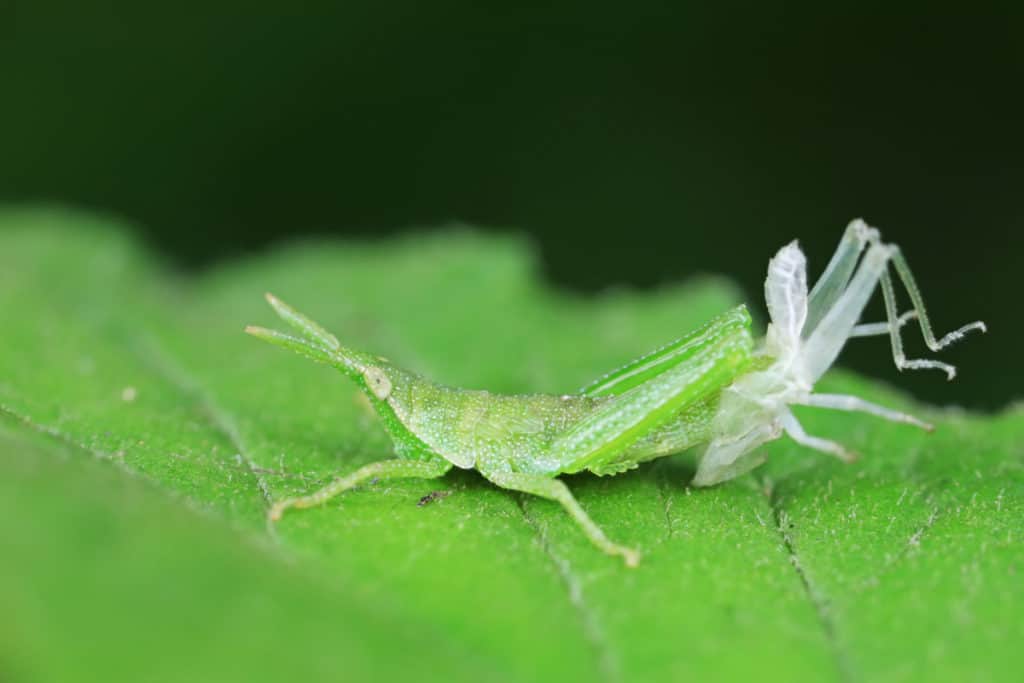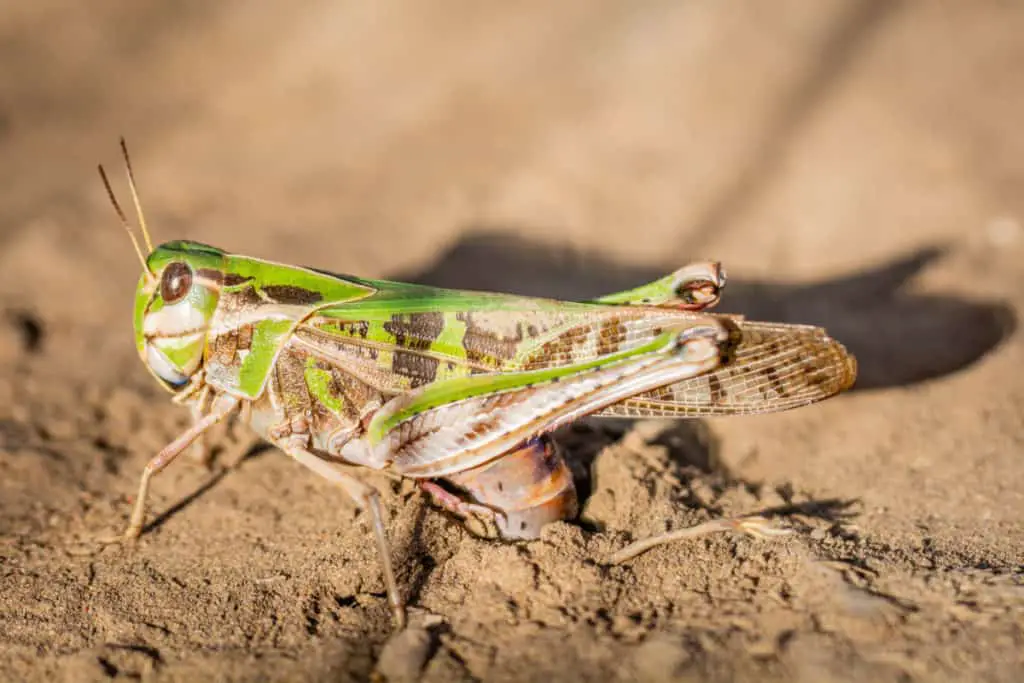Have you ever wondered why large amounts of tiny grasshoppers suddenly appear on your plants with what seems like no warning, eating away at your precious garden?
During Summer, grasshoppers lay their eggs in clusters in the soil. The eggs hatch during spring, or as the weather warms up. One adult female can lay up to 300 eggs. This is why your garden could be taken over by thousands of grasshopper nymphs within weeks of the spring breaking.
Where do these little insects come from and how many can come from a clutch of eggs? In this article, we look at this aspect of a grasshopper’s life.
A brief summary of a grasshopper’s life cycle
The grasshopper egg is the beginning of the insect’s life cycle.
Once the nymph, also known as instars, emerges from eggs, they start eating and growing.
After molting five to six times (depending on species) and growing, they will reach adulthood, where they will be ready for mating.

The female will then lay eggs underground, and die, completing the life cycle of the grasshopper.
Description of a grasshopper egg
Grasshopper eggs are not so easy to find and identify as you will not see individual eggs at the back of plant leaves or on soil surfaces.
Grasshopper eggs are generally found beneath the soil surface. They are clustered together and covered in a frothy secretion that becomes harder with time, almost like a stiff sponge.
Small soil particles, stones, and root pieces will stick to the case. These egg pods contain individual eggs, and the number, color, size, structure, and shape can vary between the different grasshopper species.
When the nymphs hatch from the eggs, the air surrounding the eggs inside the case allows them to breathe.
An old research paper by the South Dakota State University Agricultural Experiment Station, suggests egg pods of two-striped and differential grasshoppers are larger than red-legged and lesser migratory grasshoppers.
Egg pods of two-striped and differential grasshopper species measure approximately 2.5cm in length.
Grasshopper eggs can also come in a variety of colors ranging from dark brown, brownish red, yellow, olive, tan, or white.
How many eggs do grasshoppers lay?
Female grasshoppers are generally larger than males and lay eggs with an ovipositor attached to the end of their abdomens.
The females also use this attachment to dig a hole in the ground to create a safe space underground to lay eggs.
Female grasshoppers will lay several of these egg pods in the ground before finally dying. These eggs can generally be found 1-5cm below the soil surface.
The number of eggs inside a pod can of course vary between the different grasshopper species.
Red-legged grasshopper egg pods as an example can contain 25-30 individual eggs per pod. This species occurs across North America.
It is believed that a female grasshopper can lay an average of 200 eggs during their lifetime, but this can vary between species as expected.
The South Dakota State University research paper mentioned earlier suggests that it can be as many as 300 eggs. That being said, other sources suggest differential grasshopper egg pods contain 50-150 eggs.
The red-legged grasshopper can be found in Florida. Do you live in Florida? You might be interested in this article we have written, Grasshoppers In Florida: Your Complete Guide.
Where do grasshoppers lay their eggs?
Female grasshoppers will deposit eggs into the soil after being fertilized by a male. Grasshoppers will lay their eggs in various places including lawns, weedy areas, ditches, and hayfields.

However, different grasshopper species may prefer different environments to lay their eggs such as under leaves or on stems of plants.
There was a particularly severe case of grasshoppers in South Dakota in the United States of America in 193, in this instance, lesser migratory grasshoppers chose fields of standing grain or flax and the fresh stubble of crops for egg-laying. Uncultivated fields covered in plant growth were also a top choice for female grasshoppers.
This article is a great example of the above where you can view a video of someone that was fortunate enough to catch a grasshopper in the act of laying eggs.
In fact, it is suggested that grasshoppers will choose undisturbed areas to lay eggs, so tilling the soil may prevent a grasshopper from choosing a particular spot.
When do grasshoppers lay their eggs?
The time grasshoppers lay eggs may differ between species and the region, but generally, grasshoppers deposit their eggs in the ground before the cold winter temperatures hit.
The little nymphs, therefore, spend the cold winter underground, protected against the cold temperatures.
This page, Ask Dr. Universe, an initiative by the Washington State University, explains that grasshoppers can be more active during winter in areas with a warm winter season.
The earlier mentioned research paper suggested that two-striped grasshoppers deposit eggs in July, August, and September while the lesser migratory grasshoppers mature earlier and might start as early as June.
We have been talking about when grasshoppers lay their eggs, but have you ever wondered how long grasshoppers actually live? We have an interesting article on the this called, How Long Do Grasshopper Live?
How long does it take for eggs to hatch?
The amount of time a grasshopper nymph spends in the egg will depend on a variety of factors, but the main one being temperature.
Different species also react differently. Generally, once the weather warms up nicely in spring, the grasshoppers will start hatching.
All the eggs do not necessarily hatch at the same time either, the earlier mentioned research paper suggests. However, there are interesting cases where cooler temperatures might speed up the hatching process.

A study by the Illinois State University, focussed on the eastern lubber grasshopper particularly, showed that these insects have a nine-month egg stage in nature.
However, their study in the laboratory showed that these grasshoppers hatched earlier when temperatures were lower. At 22 degrees Celsius, they emerged from the eggs after 145 days, but when temperatures increased to 30 degrees 213 days.
In the experiment, the grasshoppers also all died when temperatures reached 30 degrees.
What is the hatch rate of a grasshoppers egg?
It is difficult to tell what the exact hatch rate of grasshopper eggs will be as a variety of factors influence this, and again, different species might react differently to these influencing factors.
Most studies are conducted in laboratories, so eggs in nature might not react exactly the same as those in controlled conditions.
A study done on a variety of grasshoppers in Mongolia, published in Environmental Entomology, shows that temperature affected the hatch rate.
At 15 degrees Celsius and 40 degrees Celsius, 12% and 6% of O. asiaticus eggs hatched. The A. barabensis grasshopper eggs on the other hand only saw a 2% success rate at 15 degrees, but none hatched at 40 degrees.
Threats to grasshopper eggs (climate, predators, fungal infection etc.)
Precipitation as snow does not necessarily hurt grasshopper eggs, a study suggests, but the cold temperatures halt the embryonic growth of the grasshoppers until the soil warms.
It is important to note that different species might react differently to conditions. The earlier mentioned study by Illinois State University suggests that dramatic changes in soil moisture are thought to trigger hatching in nature for some species.
It is mentioned in the same paper that extreme soil temperatures are known to kill grasshopper eggs.
In another study, it is suggested that the timing of rain plays a crucial role when it comes to grasshoppers, but precipitation before they hatch will not harm the grasshopper eggs in any way as the shell covering the eggs is nearly waterproof.
Experiments done on the egg pods of pest species show that soaking these egg cases in water for a week will not harm them. However, should grasshoppers hatch and then be caught in a heavy rainstorm, they could die.
There are several predators that can affect the eggs. Bee flies, ground beetles, crickets, and blister beetles are some of the mentioned predators.
It is believed that common field crickets can destroy up to 50% of grasshopper eggs in some cases.
Bee flies and blister beetles will lay their own eggs near grasshopper egg pods, and upon hatching, these larvae will feast on the eggs. They can be responsible for killing up to 80% of grasshopper eggs.
The Wrap Up
All grasshoppers lay eggs, and the majority of them are laid in clusters beneath the soil surface.
Grasshopper eggs are laid just before winter and hatch during warm spring months.
Each species reacts differently to the climate, predators, and will lay a different number of eggs. The hatch rate of these eggs will also differ between species.
It is therefore important to note that different species will be affected in different ways and what applies for one species of grasshopper might not necessarily be true for another species. It is important to do research and study the specific species in question.
